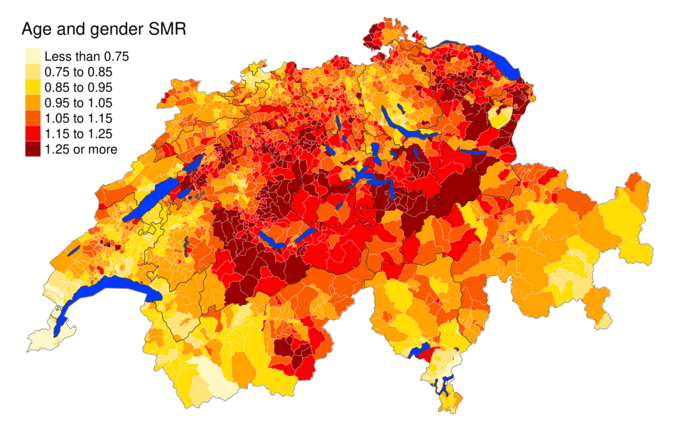Main Causes of Death Among the Elderly in Switzerland Vary by Region
12.05.2025
Researchers from Swiss TPH and partners analysed the main causes of death among the elderly (75 years and older) in Switzerland. The study found that where elderly people live affects their health risk. French- and Italian-speaking regions have lower rates of deaths from cardiovascular diseases and diabetes compared to German-speaking areas. However, these regions faced higher rates of certain cancers. The findings, published today in the Swiss Medical Weekly, can support policy-makers to better allocate resources and raise awareness for specific health risks.

Spatial distribution of cardiovascular disease mortality for the elderly (≥75 years) in Switzerland for the period 2015–2019. Standardised mortality rates (SMR), adjusted for age and gender.
The study presents the first mortality atlas for the elderly population in Switzerland. It includes detailed maps that show the main causes of death in the age group 75 years and older for all municipalities during 2010 to 2020. Using Bayesian spatial modelling, the researchers examined how causes of death varied by geographical region and looked at the influence of factors such as language region, urbanisation and income. The mortality atlas was published today in the Swiss Medical Weekly.
Between 2010 and 2020, there were almost 520,000 deaths in the elderly population aged 75 or over in Switzerland. Cardiovascular diseases, specifically heart diseases, represent the leading cause of death in this age group, followed by cancer, with lung cancer causing the most deaths in men and breast cancer in women.
Regional differences in mortality rates
Death rates from cardiovascular diseases (e.g. heart disease, diabetes and hypertension) were 16% lower in the French-speaking part of Switzerland than in the German-speaking part, and also lower in the Italian-speaking part. “Factors that likely influence the risk for cardiovascular diseases include lifestyle, urbanisation and education about disease risks,” said Taru Singhal, first author of the publication and PhD student at Swiss TPH. The population in the German-speaking part has a higher proportion of obese people than the population in the French- and Italian-speaking part, a major risk factor for cardiovascular diseases, which likely contributes to this regional difference in mortality rates. In addition, there is a higher awareness in the French and Italian-speaking regions, where hypertension is more commonly screened, which may also help to reduce deaths rates.
More deaths from liver cancer in the French and Italian parts
The study found that cancer mortality rates were similar across Switzerland, with the exception of liver cancer. In the Italian-speaking regions, the mortality rate was almost double that of the German-speaking regions, and almost 40% higher in the French-speaking regions. This may be due to higher rates of alcohol consumption and tobacco use in these regions, which are both risk factors for liver cancer.
The impact of the COVID-19 Pandemic
In 2020, COVID-19 emerged as a new cause of death and the highest number of death was recorded in this year. Death rates from COVID-19 were 6-7% lower in the German-speaking regions. Findings suggest that the willingness to follow public health measures, such as wearing masks and social distancing was greater in these regions, leading to lower transmission rates and ultimately fewer mortality rates.
Socioeconomic factors
Socioeconomic factors such as income, education and place of residence are important health determinants and may further explain the geographical differences in cause of death. Generally, those with higher incomes have lower death rates, while those with lower incomes are more likely to develop chronic diseases and have less access to healthcare and preventive services.
The mortality atlas provides a better understanding about where health services are most needed, and allows for better-targeted health interventions for Switzerland’s ageing population. “The knowledge of the geographical distribution of the cause-specific mortality rates, particularly among the elderly population, can help physicians, nurses, healthcare professionals and policymakers allocate resources more effectively,” said Penelope Vounatsou, senior author and Head of the Biostatistics unit at Swiss TPH.
About the study
The study was funded by the Swiss National Science Foundation under the INSPIRE project, led by the Institute of Nursing Science, University of Basel, which focuses on the implementation of an integrated community-based care programme for home-dwelling senior citizens.
Contact

Penelope Vounatsou
PD, PhD
Group Leader, Head of Unit
+41612848109
penelope.vounatsou@swisstph.ch
Stay connected
Subscribe to our newsletter and get all the latest research news, project updates, course and event listings from Swiss TPH.